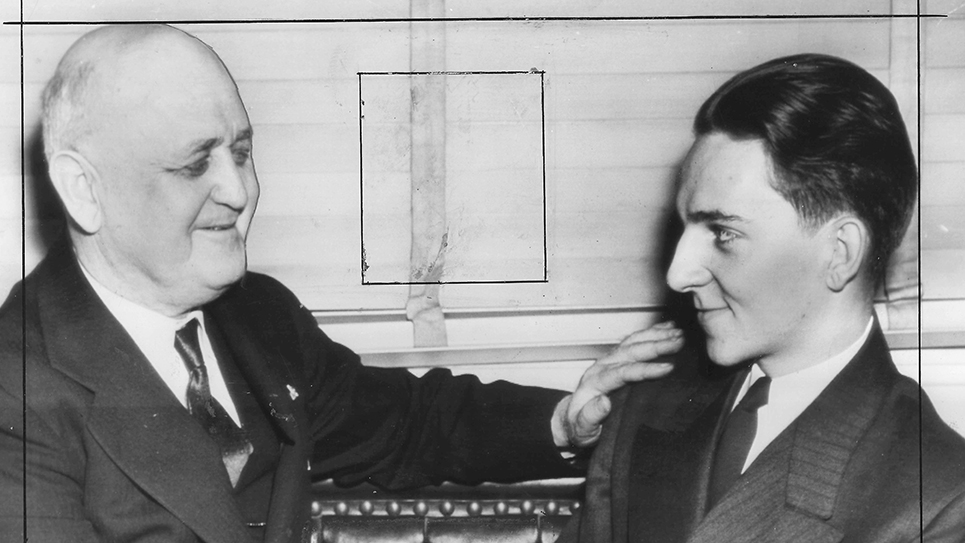By Ray Hill
Austin Cate, Knox County’s sheriff, had won resounding victories in both the Republican primary and the general election in 1948 to win reelection. Cate had faced formidable opposition in the GOP primary from former Finance Commissioner Ed Burchfield and C. W. “Buddy” Jones in the general election. Cate and Jones would become intense political rivals and fight three hard-fought election campaigns against one another.
Born Richard Austin Cate September 10, 1901, the future sheriff was named for Richard Wilson Austin, who was U. S. Marshall for the Eastern District of Tennessee when his namesake arrived in this world. Austin would go on to win the election as the congressman from Tennessee’s Second Congressional District in 1908 and remained in office until defeated in the Republican primary in 1918 by J. Will Taylor.
Austin Cate had gotten his start in law enforcement when his father William Thomas Cate had first been elected sheriff. Sheriff W. T. Cate couldn’t drive so he employed his son to drive him. Austin Cate had been Chief Jailer under Sheriff J. Wesley Brewer and chief deputy under his cousin, Sheriff J. Carroll Cate.
Cate had first been elected sheriff in 1946 and had been easily reelected in 1948. At the time, sheriffs could serve three two-year terms consecutively before being term-limited out of office. Although eligible to seek a third two-year term, few incumbents seemed to wish to risk it. Apparently, third terms were elusive as the people of Knox County seemed reluctant to grant an incumbent three terms in a row. There was good reason to believe Austin Cate could repeat the feat accomplished by the late Hazen Kreis, who had been the last Knox County sheriff to win a third consecutive term. Sheriff Cate duly filed his papers to run in the Republican primary in 1950. A total of 84 candidates filed to run in the GOP primary of 1950; 41 filed to run for county office, 10 for the school board and 14 lucky incumbents had no opposition in the primary. Austin Cate faced three challengers inside the primary – – – U. G. Turner, William F. “Bill” Sowder, and Garfield Swanner.
On April 17, 1950, Sheriff and Anna Drinnen Cate, who had been married for 17 years, welcomed the arrival of their son and only child, Richard Thomas, named for both his father and grandfather, as well as his maternal uncle. A pleased Sheriff Cate reported mother and son were fine.
Austin Cate turned back his challengers in the primary and went onto the general election where he faced a rematch with “Buddy” Jones. The Knoxville News-Sentinel, even then a Democratic newspaper, published an editorial shortly before Election Day urging Knox County voters to “Break Up This Clique.” The editorial sniffed that Sheriff Austin Cate campaigning upon his record wasn’t “doing or saying much concerning that record which, in the past two years, has been a rather dismal one.” The editorial stated Buddy Jones was running “an extremely effective campaign” and had “revealed” the “manner in which bootleg and gambling joints are being permitted to operate in wide-open fashion.” The News-Sentinel reminded readers it had repeatedly stated prohibition did not work and had urged voters to allow the legal sale of liquor through stores, but until that day, the editorial said Sheriff Cate should make it much more difficult for “bootleggers to operate.” Buddy Jones, the editorial noted, had promised to do just that. “Sheriff Cate is a member of a little Court House group which to a large extent has control over the affairs of this county, including law enforcement and prosecution.” The News-Sentinel huffed it was “an expensive and unhealthy situation” which the voters should tear apart. “The best way to break it up,” the editorial wailed, was to “elect Buddy Jones as sheriff.”
Knox County Republicans won 17 out of 20 offices before the voters. C. W. “Buddy” Jones upset Austin Cate in the sheriff’s race. The key to Jones’ victory was his margin inside the City of Knoxville. The 1950 election was described in news reports from the time as “the biggest and hottest in Knox County history.” The race that attracted the most attention was the contest for sheriff where 39,820 Knox Countians cast ballots, a record. Two years earlier 26,970 Knox Countians had gone to the polls, which had been the record turnout until 1950.
Jones only narrowly edged Cate out of the sheriff’s office and became the first Democrat since Chester Hackney to win since 1930. Clarence Walter “Buddy” Jones was expected to clean out the Knox County Sheriff’s Department of Cate appointees and supporters. Buddy Jones probably would have had difficulty being reelected in any case, but a murder on March 31, 1951, likely doomed his chances at the ballot box in 1952. March 31 was a Saturday afternoon and twenty-seven-year-old housewife Mary Elizabeth Hankins had prepared lunch for her husband and afterwards kissed him goodbye and began washing the dishes when an unexpected caller arrived. When Fred Hankins came back home, he was horrified to find his wife lying in a pool of her own blood on the floor of their new home. Mary Elizabeth Hankins was rushed to St. Mary’s Hospital where she was pronounced dead upon arrival. Sidney Wolfenbarger, Knox County Coroner, said ominously, “It was definitely murder.”
Fred Hankins was only gone for about an hour to pick up his car at the garage. The Hankins home was on Crestwood Road in “a wooded section of Fountain City.” Both law enforcement officers and the coroner were puzzled by the angle of the .32 caliber bullet that had ended the life of Mary Elizabeth Hankins. The bullet had entered slightly above her left ear, yet the trajectory spiraled downward and lodged in her brain. Contemporary news reports did not exactly inspire confidence in Coroner Wolfenbarger who had conducted the autopsy and had opined Mrs. Hankins’ death was “either suicide or murder.” Apparently Wolfenbarger had made up his mind by the time he talked to reporters to say it was most certainly murder. Even more alarming, originally the coroner had said Mary Elizabeth Hankins’ death appeared to have been caused by blunt force trauma. The body of Mary Elizabeth Hankins could be seen from the picture window in the living room of her home; she was found lying on her right side with her face on the floor. Investigators speculated Mrs. Hankins had been knocked to the ground and shot. Considering the trajectory of the bullet, some investigators thought Mrs. Hankins could have been standing when the shot had been fired. There was no powder on her body. Fred Hankins and Mary Elizabeth Tabler had grown up together two miles from each other in the Graveston community near Corryton. They had gone to elementary school together, as well as Gibbs High School.
Buddy Jones declared he would not go to bed until the killer of Mary Elizabeth Hankins was found. The crime remains unsolved to this day and apparently, it was the Knoxville Journal that promptly christened the sheriff “Sleepless” Jones. The moniker stuck to Jones for the rest of his life. Guy Smith, an unabashed Republican and editor of the Knoxville Journal, seemed to delight in torturing Jones in print. Perhaps that explains a headline in the Journal screaming, “Missing Automobile ‘Found’ Right Under Sheriff’s Nose.” A smaller headline chortled, “Car Reported to C. W. (Sleepless) Jones July 4, Finally Appears in His Parking Lot.” The car, which had been reported stolen, was finally found in the parking lot behind the old county jail. “The most charitable explanation,” the Journal declared, “is that the sheriff and his staff have been so busy trying the solve the 109-day old murder of Mrs. C. Fred Hankins in her Fountain City home they haven’t had time to look for stolen or lost automobiles.”
“The murder hasn’t been solved either,” the Journal reminded its readers.
Another banner headline in the Knoxville Journal of December 2, 1951, roared, “Hankins Slayer Free After Lapse of 213 Days…Sheriff C. W. (Sleepless) Jones Still Has No Evidence On Crime Perpetrator.”
“Late last March Sheriff C. W. Jones vowed not to go to bed until he named the person who on March 31 snuffed out the life of Mrs. C. Fred Hankins with a single blast from a 32-caliber pistol in her Fountain City home,” the Journal reported. “After eight months the sheriff has not yet revealed the identity of the cold-blooded murder[sic] who shot a hole in the top of the young matron’s head as she was preparing a chicken for her husband’s Sunday dinner.”
Considering the circumstances, it could have surprised nobody when Austin Cate announced he would try and reclaim the sheriff’s office in 1952. “I have received numerous requests from friends that I should offer myself again,” Cate explained, “and I have decided to respond to their urging. Many people seem to feel that successful experience in law enforcement is very desirable in a candidate for the office of sheriff.” With the death of Mary Elizabeth Hankins, it was quite likely a gross understatement. It was hardly shocking Austin Cate stressed the number of crimes his department had solved during his tenure as sheriff. Cate pointed out while he had been sheriff the department had solved more than 300 cases of “house-breaking and larceny”, as well as 100 break-ins by juvenile offenders. It had been Sheriff Austin Cate and his department that had put the “Torch Gang” out of business and in jail. A notorious outfit known for safe-cracking, Cate and his deputies had caught the five gang members who were promptly convicted by a jury.
Austin Cate easily beat his rivals for the GOP nomination for sheriff, setting up another contest with C. W. “Buddy” Jones. The Republicans swept the courthouse yet again in 1952 with former sheriff Austin Cate ousting his successor “Sleepless” Jones. Cate had easily outdistanced Jones to win back the sheriff’s office.
1954 was the first election in Knox County to utilize voting machines and the primary election was marked by “party strife and untold confusion” because of the voting machines. Sheriff Austin Cate turned back the challenge of City Councilman U. G. Turner by a 2 to 1 margin in the GOP primary. The Democrats upset several Republicans in the 1954 general election, but Austin Cate was not one of them. Paul Lilly, Chief Deputy to former Sheriff Buddy Jones, was the Democratic nominee and he ran closer than expected but fell short of victory.
After leaving the sheriff’s office, Austin Cate returned to the Knoxville Housing Authority. With a Republican president occupying the White House, there was speculation Cate might end up in the office of the U. S. Marshall for the Eastern District of Tennessee, but it was never to be. When death finally claimed him, Austin Cate was working as the assistant director of the Knoxville Housing Authority. Known for his kindly nature, Cate was friends with “hundreds of youngsters of the housing projects’ families.”
Austin Cate, a heavy smoker, died April 12, 1966, from throat cancer. Suffering from the effects of cancer for several months, Cate had gone into the hospital for major surgery in an attempt to remove the malignancy. The former sheriff was able to return to his farm off Thorngrove Pike and Kodak Road, which had once belonged to his own father, just before Christmas in 1965. Remembered as “a calm and reasonable operator,” the quiet, yet firm Austin Cate had enjoyed a quiet life with his wife and son.
The people of Knox County had placed their faith in the soft-spoken, but steady hands of Richard Austin Cate four times. Austin Cate never failed them. There had never been a whiff of scandal during his administrations as Knox County’s sheriff. Austin Cate did the job to which he had been elected and did it well. That is as fitting a tribute as any public servant could hope for or ask, especially a sheriff.






